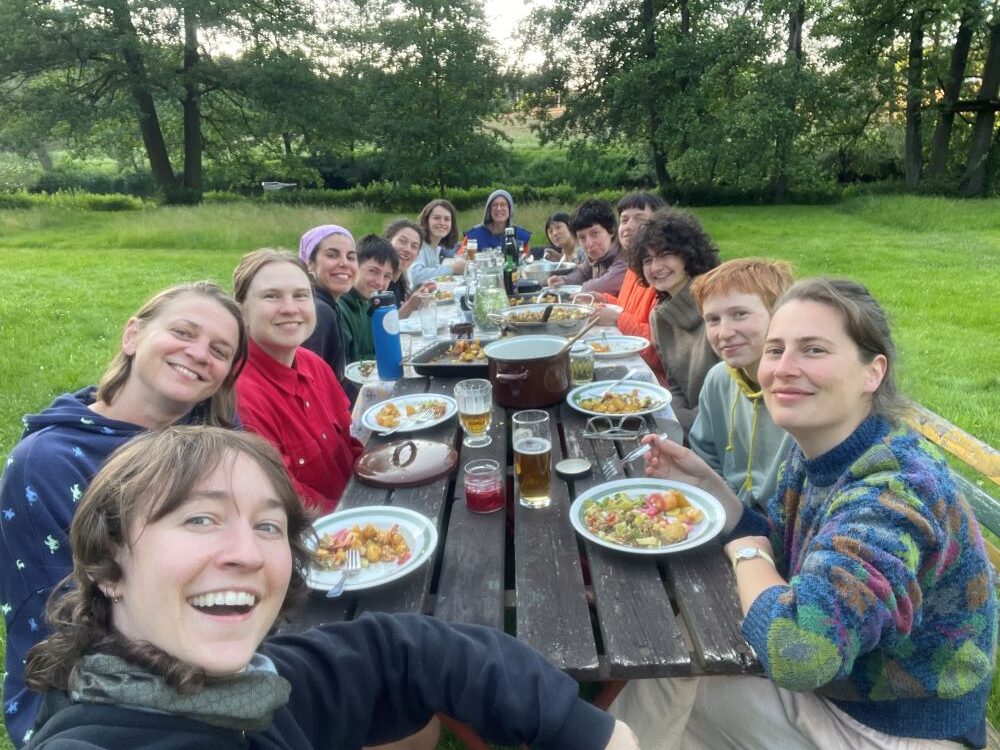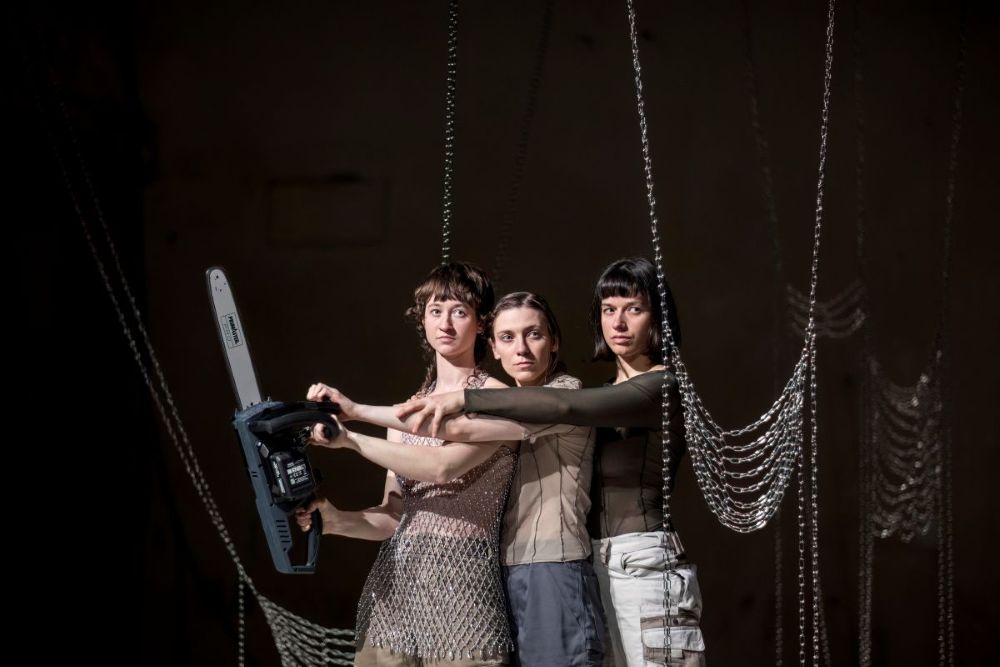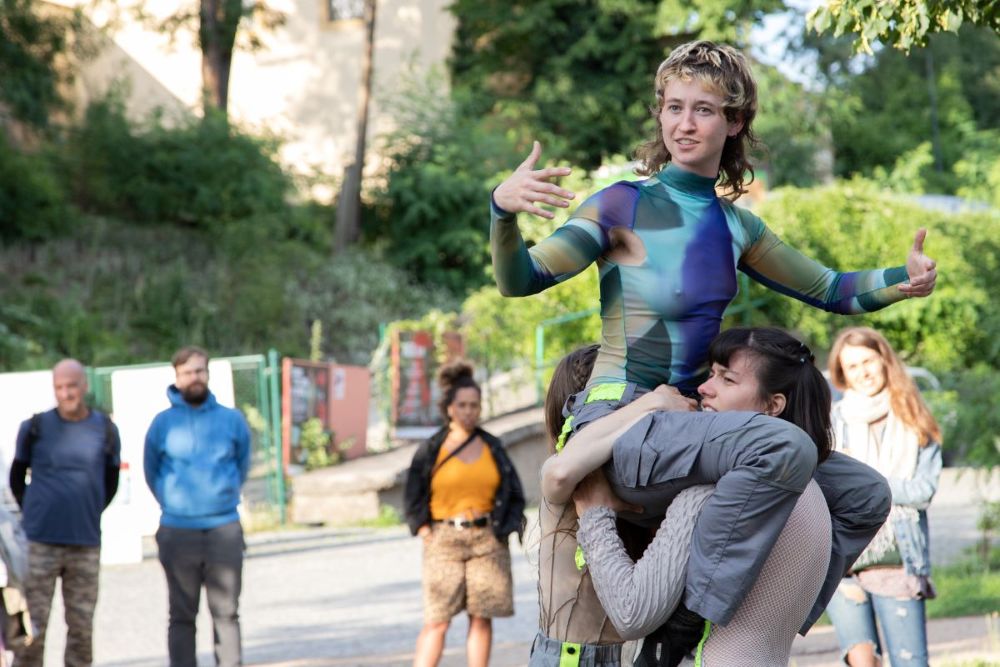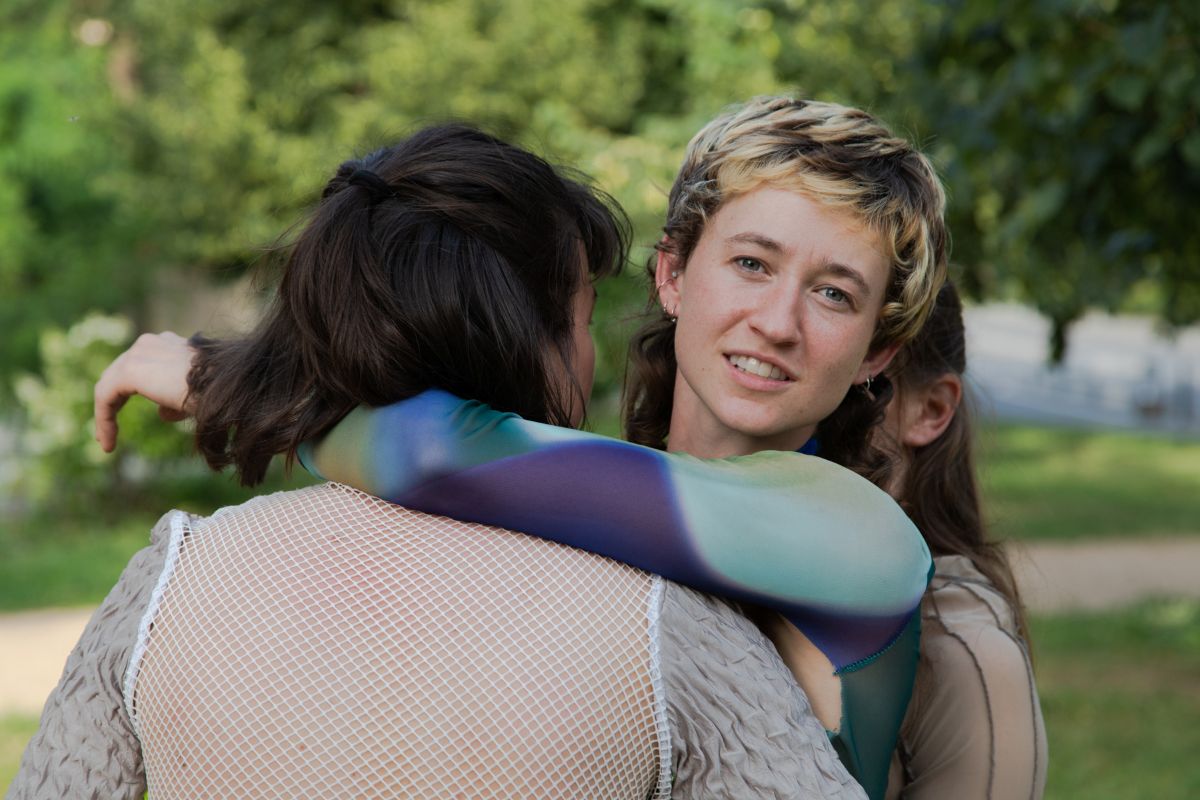written by Breeanne Saxton and Hana Polanská
From June 16–24, the second edition of the international residency, symposium, and performative gathering DANCETOPIA 2025 took place at ALTA Air Camp in Kounice and Studio ALTA in Prague. With care, regeneration, and ecology as its central motifs, the event brought together artists from around the world. Through site-specific practices, they explored movement, relationality, and landscape. The curatorial team – Katarína Bakošová (SK/CZ), Neva Guido (US), Alica Minar (SK/CZ/DE), and Breeanne Saxton (US/DE) – operating between Berlin and Prague, created a fertile ground for rethinking the role and function of art in contemporary society. The residency was hosted by dancer, mentor, and dramaturg Lucia Kašiarová in her beautiful riverside space near the Sázava River.
One of the curators, Breeanne Saxton, shares in her essay a deeply personal, raw, and critical reflection on her love story with dance, from adolescence to the present. Through her own embodied experience, she unpacks the systemic pressures of artistic education, neoliberal individualism, burnout, and the long arc of transformation. Her writing weaves together poetics, vulnerability, and political imagination, offering an alternative approach to co-being through humor, embodied presence, clowning, and radical care.
Breeanne shared her story of burnout with us during the car ride to the residency, and from that moment, I somehow knew that this woman, this dancer, this curator had something important to say. Especially about a theme I am also currently exploring: how dancers and performers, through their own embodied experience – and through the ways how the system enacts its violating power on the body – open up deeper reflections on care, rest, regeneration, labor, working conditions, the place of women in society, and the persistent culture of patriarchy, racism, and competition. These systems are intrinsic to neoliberalism and capitalism. And they urge us to go further – to think critically and relationally, also in broader geopolitical and climate contexts.
—
Hello, dear reader.
My name is Breeanne Camille Saxton, and I want to tell you my love story with dance, from the first improvisational rapture, to the dreams of fame, and through the playgrounds of failure and heartbreak. It’s not original or unique, but it is exactly what happened.
Look, this is me practicing vulnerability., I’m not a scholar or an academic, but an artist and a teacher and a fool. What I will try to do is frame my experience in a kind of larger context. So much still sits between the lines and falls through the cracks. Oh well.

As a young teen, my first heartbreak was quitting gymnastics after 10 years of training due to pain and declining progress. Soon thereafter, I fell in love with dance. The ability to discover and express my inner world through my moving body was a revelation- one of my first transcendental experiences was discovering improvisation at 15 years old. This almost religious possession with dance led me to pursue it in the university system, despite my parents coming from a working-class background with no network or knowledge about the arts. I was clueless as to what it means to be a working dance artist in America, and my passion and belief in the object of my desire was strong enough for any warnings about my future to go unheard and unheaded. I don’t regret a thing. I still am in love with dance, and in some ways more protective over Her than ever.
So, I began studying dance as a Form of Knowledge in The University System at 17. I had exceptional professors, to whom I am very grateful. Retrospectively, I can see, however, how The University System was where the purity of my relationship to dance began to shift.
The University System emerged from a colonial context and an Enlightenment period understanding of the categorization, production, mastery, and distribution of knowledge. Oftentimes, Universities were (still are) functions of The State, and this structural foundation is intentional training to behave according to the State’s explicit and implicit Law and Order. So at The University, even dance is a Thing that can be acquired, mastered, and distributed by The Knowledge Holders. Dry knowledge for a drying-outdrying out world.
When I entered university, I was blindly motivated, passionate, and totally bought into this system, well I didn’t even have the tools to see it, the system was invisible to me. I trusted the University and I trusted my professors, who were indeed shining pillars of wisdom and guidance for me. I was liberal in my politics, sure, but I wasn’t questioning The University itself. I believed them when they said I needed a form of discipline that was also a form of violence on the body. I wanted the recognition that came from overcoming physical limitations to achieve virtuosity. I internalized the competitive mentality. I wanted to be the best. I would cry after (or during) technique class because I wasn’t able to execute the material PeRfEcTlY! I still to this day suffer from a chronic injury I got after failing to master a turn after class, so I did it with anger, and the result was a torn ligament which has never healed.
That drive caused a degree of MaStErY, but also an addiction to comparison and flimsy self-worth.
Am I a good dancer?
I never felt good enough, no matter how much praise I got, I felt like a failure.

That structure continued into the professional world- the quality of encounters, experience, and process didn’t matter. It was about reproducing artworks that served a particular aesthetic and social norm. The environments were often rigidly hierarchical. Among dancers, there were power games, domination, seniority rules. People took space from others because space had been taken from them. This generational trauma spread, even within so-called progressive art spaces. Now I can see clearly that these spaces are embedded in a neoliberal frame, but at the time, I placed the blame on myself, as I was taught to do.
Not strong enough, not talented enough, not multi-talented enough, not creative enough, not edgy enough, not queer enough.
I quit company life, I was just too weird, too punk, too stupid, too slow, too fast, too many ideas, too independent, too loud, too dreamy, too conceptual
But freelancing brought more of the same. I blamed myself.
System failure…
This individualization of failure is a cornerstone of neoliberal thinking. It took years, mental illness, and unrecognized grief to begin seeing what was really going on. The dance world didn’t offer much solace. It still promotes a do-it-yourself myth: If you’re not succeeding, you’re just not good enough.
From about 25 to now (I’m 31), I’ve been trying to remove myself from the “hero role” — recognizing that my “failures” are systemic, not personal. Burnout is not unique to dancers or artists. It’s a broader symptom of the late capitalist structures we live in. But artists are often expected to persist purely out of passion — as if that passion alone should sustain us.
I felt spurned by dance and my love for Her was shrouded in doubt and self-harm: What I was striving for was harming me—and others. I had tried to be an exceptional, heroic performer, dancer, choreographer. I wanted success as I’d been taught to define it. Rationally, I had begun to understand that recognition, prize money, and high-payinghigh paying contracts don’t lead to true happiness but knowing that in theory and integrating it in practical experience are very different things. That integration takes time.
Changing neoliberal patterns is a generational task. Our children will inherit what we are learning now. As humans, we are impatient—we want transformation quickly. But unlearning takes time. Learning to sit in ambiguity is a skill. One that artists can teach to their communities.

In Dancetopia, for example, there’s a lot that flows smoothly, and a lot that doesn’t. There is conflict — as in any human collaboration — but learning to engage in conflict differently has become a key focus for me. Not just the success of a symposium, but how we work, how we fight, how we address breakdowns, how we collaborate — that’s where the real material is.
Most important first is recognizing the old patterns as they emerge…I still find my ego wanting to be seen, to be validated—because this is how I was taught to feel safe and loved: by being important, talented, skilled. But to be needy, to ask for help, to be strange, to not belong, to make mistakes and be excluded—that is still painful. There’s a lot of performative weirdness in artistic spaces, but to really be strange is something else. We still really don’t know how to integrate difference.
Even in Dancetopia, when we try new ways of being together, people often return to the familiar. Like how decision making often reverted very quickly to voting — it’s clear, efficient, and makes people feel secure. Sitting in the unknown is a skill. But artists are uniquely able to hold two opposing truths in the mind at once. That’s a power. It’s a way to navigate our paradoxical world, where things are simultaneously getting better and worse.
Artistic processes have social implications. The product is necessary, but it’s the processes that change society. Artists are realizing that keeping those processes insular is too slow. That’s why my work continues to more and more blur the lines between facilitation, workshops, experience, and performance. And indeed, many practitioners have been doing this for a long time!
One reference I love is the Reshape Project, and particularly a working group called the Department of Civil Imagination. It’s magical thinking, speculative thinking — storytelling for worldly expansion (Donna Haraway). This Department gives practical advice for imagining new futures and developing compassionate strategies to live, fight, resist, work, and die together.
Ok, so, Dance, for example, historically—was always just as important to DO as it was to witness. Both roles must coexist. And now, most people are no longer dancing; they’re barely
moving. We are disconnected from our bodies. Just stretching on the street is seen as odd. So do that more!
So I’m interested in how to get people to buy into embodied knowledge.
And yes, I’m optimistic. I worry about the future—about my children (though I don’t have any yet) but I think life is worth living. There’s so much work to be done. I don’t want to give up.
As for activism, I’ve often felt like I’m not ‘enough’—but that insecurity is part of the very same structure I’m trying to unlearn. I don’t organize political protests. I create dance, clowning, and comedy events that invite people to access their inner fool—to disobey. That work isn’t explicitly about geopolitics, but it is a political resistance to the physical and social rules we are taught to obey. I am politically engaged, but in a way that is less forward-facing than a lot of my peers. I still hesitate to call myself an activist, though. I’m doing what I can.
Clowning/ comedy saved me. It helped me re-engage with performance through joy and humor. The clown has historically been a spiritual figure, bringing society’s darkest truths into the light and exposing their absurdity. I spent the early part of my career doing very heavy, serious work. I needed to. But now I can laugh about it. That’s been a very powerful and liberating shift.
This tool—joy as resistance—is critical for me. It’s not about making casual jokes about suffering, but it is about holding our suffering up to the light in order to access joyful mischief, disruption, and to develop the emboldened capacity to uproot and destroy complacent normalcy. It’s confronting. It brings up shame, fear, and old habits. That’s why I’m also studying dance therapy—to better hold space for all of that.
It’s serious fun, it’s serious work. And it’s the work I care about most.




